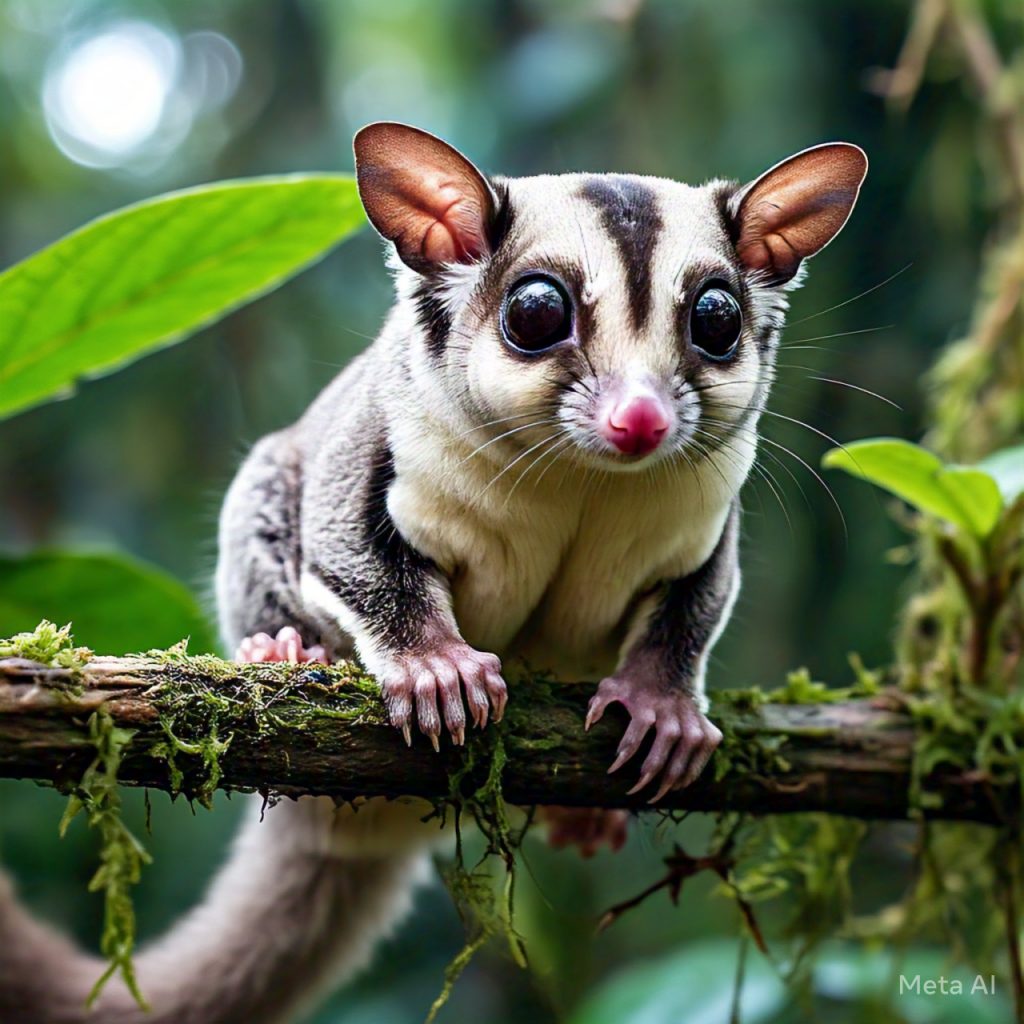The sugar glider (Petaurus breviceps) is an adorable, small, nocturnal marsupial native to Australia, Papua New Guinea, and surrounding islands. With its gliding ability, playful personality, and unique care needs, the sugar glider has become a popular exotic pet. However, owning one is a significant commitment requiring specialized knowledge and preparation.
In this guide, we’ll dive deep into sugar glider biology, behavior, care, and considerations for prospective owners.
What is a Sugar Glider?
Sugar gliders are small marsupials closely related to possums. Known for their ability to glide through the air using a membrane of skin called the patagium, they are named for their love of sweet foods and their gliding skills.
Physical Characteristics
- Size: 5-7 inches in body length, with a tail roughly the same length.
- Weight: 4-5.5 ounces.
- Lifespan: 10-15 years in captivity.
- Distinctive Features:
- Large, dark eyes adapted for night vision.
- Soft, gray fur with black stripes and white underbellies.
- Prehensile tails for climbing and balance.
Natural Habitat and Behavior
Where Do Sugar Gliders Live?
In the wild, sugar gliders inhabit forested regions, including eucalyptus forests, rainforests, and savannas. They are arboreal creatures, spending most of their time in trees.
Social Structure
Sugar gliders are highly social animals that live in colonies of 6-10 members. They rely on vocalizations, scent markings, and physical grooming to communicate and bond.
Nocturnal Lifestyle
Being nocturnal, sugar gliders are most active at night, foraging for food and interacting with their colony members.
Diet and Nutrition
What Do Sugar Gliders Eat in the Wild?
Their diet consists of:
- Sap and Gum: From eucalyptus and acacia trees.
- Nectar and Pollen: Sweet plant products.
- Insects: A primary protein source.
- Fruits: For natural sugars and hydration.
Captive Diet
A balanced sugar glider diet includes:
- Protein: Boiled chicken, eggs, or specially formulated glider pellets.
- Fruits and Vegetables: Apples, pears, berries, carrots, and leafy greens.
- Calcium Supplements: To prevent calcium deficiencies and related health issues.
- Treats: Honey or yogurt drops sparingly.
Proper diet is crucial to avoid malnutrition, obesity, or metabolic bone disease.
Sugar Gliders as Pets
Legal Considerations
Before acquiring a sugar glider, check local regulations. Ownership is restricted or requires permits in some states and countries due to concerns about invasive species or improper care.
Enclosure Requirements
Sugar gliders need spacious and stimulating environments:
- Cage Size: At least 24x24x36 inches, though larger is always better.
- Bar Spacing: No wider than ½ inch to prevent escapes.
- Accessories: Include branches, ropes, hammocks, and exercise wheels for climbing and play.
- Temperature: Maintain between 75-80°F, as sugar gliders are sensitive to cold.
Time and Commitment
- Sugar gliders require 2-3 hours of daily interaction to stay socialized and healthy.
- They thrive in pairs or small groups, as loneliness can lead to stress and behavioral issues.
Health and Wellness
Common Health Issues
- Nutritional Deficiencies: Often due to an improper diet.
- Stress-Related Behaviors: Overgrooming or self-mutilation from isolation.
- Infections: Including respiratory and gastrointestinal problems.
- Injuries: From unsafe environments or handling.
Veterinary Care
Sugar gliders require exotic pet veterinarians who are familiar with marsupial health. Annual check-ups and immediate care for injuries or illnesses are essential.
Behavioral Traits
Gliding Ability
Sugar gliders use their patagium (a flap of skin stretching from wrist to ankle) to glide distances of up to 150 feet in the wild. This behavior helps them forage and escape predators.
Communication
These marsupials are vocal animals that use a variety of sounds to express themselves:
- Barking: To communicate or alert others.
- Hissing: As a sign of comfort or mild irritation.
- Crabbing: A loud, defensive sound when frightened.
Benefits of Owning a Sugar Glider
- Bonding Experience: Sugar gliders form strong connections with their owners, often riding in pouches or sitting on shoulders.
- Low Maintenance Grooming: They groom themselves and each other.
- Unique Companionship: Their playful, curious nature provides endless entertainment.
Challenges of Sugar Glider Ownership
- Specialized Diet: Requires careful preparation to meet nutritional needs.
- Nocturnal Behavior: Their active hours may not align with your schedule.
- Cost: Initial setup (cage, accessories, and gliders) can range from $300-$1,000.
- Long Lifespan: A 10-15 year commitment.
Breeding Sugar Gliders
Breeding sugar gliders requires expertise and responsibility.
- Gestation Period: 15-17 days, followed by 60-70 days in the mother’s pouch.
- Litter Size: Typically 1-2 joeys.
- Weaning: By 8-10 weeks old, joeys can eat solid foods.
Ethical breeding practices and ensuring the health of both parents and offspring are paramount.
Conservation Status
Sugar gliders are not endangered, but habitat loss in their native regions poses challenges. Sustainable breeding programs and responsible pet ownership help reduce the impact on wild populations.
Interesting Facts About Sugar Gliders
- Marsupial Heritage: Like kangaroos, sugar gliders carry their young in a pouch.
- Remarkable Memory: They can recognize their owners and even return to them during gliding.
- Scent Marking: Sugar gliders use glands on their heads and chests to mark territory and bond with colony members.
Conclusion: Is a Sugar Glider Right for You?
Sugar gliders make wonderful pets for dedicated and knowledgeable owners who can meet their unique needs. Their social nature, playful antics, and fascinating biology make them a joy to care for—but only if you’re ready for the commitment.
If you’re considering adding a sugar glider to your family, educate yourself thoroughly and ensure you’re prepared to provide the care these amazing creatures deserve.

